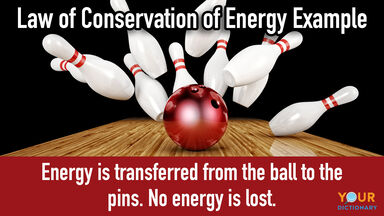Which Statement Best Describes the Law of Conservation of Energy
You might be interested. Rather it can only be transformed or transferred from one form to another.

Environmental Impact Statement Eis Under United States Environmental Law Is A Documen National Environmental Policy Act Human Environment Environmental Law
Matter can be converted to less massive things.

. When you rub your hands. If there is no net force acting on a Science We know that the law of conservation of energy states that energy can not be created or destroyed. The correct option is B.
The objects height above ground t seconds after the fall is stequals400 minus 16 t squared. Energy is neither created or destroyed. Which definition best describes the.
Determine the velocity and acceleration of the object the moment it reaches the ground. See answer 1 Best Answer. All matter contains the same mass.
Which statement best describes the law of conservation of energy. Assume that the energy input in this case is chemical potential Science 1. Mass can be either created or saved in a chemical reaction.
Select the THREE answers that are correct. A finite amount of carbon exists on Earth and it moves through living and nonliving materials through the carbon cycle. Energy cannot change forms in closed systems.
This law means that energy can neither be created nor destroyed. Of 10 Which statement best describes the law of conservation of energy. Matter can be converted to more massive things.
In physics and chemistry the law of conservation of energy states that the total energy of an isolated system remains constant. Which of the following statements is most accurate. Law of conservation of energy.
Initially the object has gravitational. Which statement is true according to the law of conservation of energy. Proof At point A.
The Law of Conservation of energy states energy is neither created nor destroyed only changed from one state to another. The total energy in an open system can only decrease. Energy changes forms and is neither created nor destroyed.
Energy can be created but not destroyed. Which statement best describes the relationship between the mass of a substance and how much energy is needed to. Correct answer to the question Question 1 of 10 Which statement best describes the law of conservation of energy.
Law of Conservation of Energy Energy is neither created or destroyed in an isolated system it just changes from one form to another or transfers from one part of the world to another. The Law of Conservation of Energy states. Energy can be destroyed only in open systems.
It is said to be conserved over time. Which statement best describes how photosynthesis follows the law of conservation of energy. Select examples of energy changing forms.
The total energy in an isolated system can only decrease. The correct option is C. The law of conservation of energy states that energy can neither be created nor be destroyed.
Energy can be destroyed only in open systems. Energy is neither destroyed nor created during energy transformations. However energy can change from one form to another.
Train using coal as fuel as shown in the diagram above. In the powering of the train. Law of conservation of energy states that Energy can neither be created nor be destroyed.
What is the law of conservation of energy quizlet. Energy can be created or destroyed. Which of the statements below best describes how the Law of Conservation of Energy plays a role.
Select the statement that best describes the function of heating and cooling in PCR. Mass is neither created nor destroyed in a chemical reaction. Light energy from the Sun is converted into chemical energy in plant cells.
An object is dropped from a tower 400 ft above the ground. Furthermore what is conservation of energy with example. Consider this energy transformation diagram.
Energy can be destroyed but not created. 554 students attemted this question. Which statement best summarizes the law of conservation of energy.
Energy transforms from one form to another form and potential energy kinetic energy constant. This statement is known as law of conservation of energy and it implies that whenever a certain form of energy does change the loss of this form of energy must have converted into an another type of energy. Maria analyzed the different types of energy transfers and transformations involved in powering a.
Energy is neither created or destroyed. Energy cannot be created or destroyed. It only changes form.
Energy can change forms but cannot be created or destroyed. Hence in a system energy might change forms but the total energy on Earth remains the same. Total amount of energy associated with the random movement of atoms and molecules in a sample of matter.
The velocity of the object the moment it reaches the ground is nothing fts. Which of the following statements best describes the Law of Conservation of Mass. Heating facilitates strand denaturation and.
The total energy is conserved and does not change. The law of conservation of matter states that matter cannot be created yet matter is sometimes gained or lost to an ecosystem. Energy cannot change forms in closed systems.
The law that states that energy cannot be created or destroyed but can be changed from one form to another. Which statement best describes the law of conservation of energy. The amount of energy will always stay the same.
Which statement best describes the flow of energy and matter through the terrestrial ecosystem. A typical example is an object falling to the ground. The amount of energy will always stay the same.
Energy cannot be created or destroyed.

Law Of Conservation Of Energy Video Khan Academy

Which Statement Describes The Law Of Conservation Of Energy In 2022 Conservation Of Mass Conservation Law

No comments for "Which Statement Best Describes the Law of Conservation of Energy"
Post a Comment